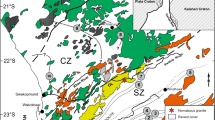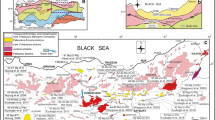Abstract
Obduction of the late Ordovician Solund-Stavfjord Ophiolite Complex (443±3 Ma), west Norwegian Caledonides, involved generation and high-level emplacement of granitic and granodioritic dikes and plutons. Initial 87Sr/86Sr ratios in the granites are low (0.7042–0.7059), suggesting either a mantle component or a Rb-poor crustal source. Initial εNd (εNd(t)) ranges from-0.8 to-8.8, indicating that the granites represent recycling of old crustal rocks, which is supported by Precambrian inheritance in zircons from two of the studied granites. I argue that the Rb-Sr and the Sm-Nd isotope systems are decoupled in the sense that the Sr-and the Nd-isotopes derive their dominant signals from two different sources, a mantle source and a crustal source respectively. The granites are metaluminous to peraluminous and typically have high Sr, Ba and Na2O/K2O ratios. SiO2 contents range from 66 to 74 wt%. REE abundances are highly variable; the La contents range from ∼80 to ∼200 times chondrite, and are inversely correlated with the contents of SiO2. The concentration of Nd in the granites decreases asymptotically with decreasing εNd(t) suggesting fractional crystallization of accessory phases and assimilation of continental crust. This argument is supported by the presence of partly dismembered xenoliths in the granites with εNd(t)-values that are significantly lower than εNd(t)-values in the host granite. The following models are suggested for the granites. When the ophiolite complex obducted, an outboard subduction zone approached the continental margin, and subduction-related magmas accumulated beneath the continental margin, and probably intruded the overlying eugeosynclinal deposits. The mantle-derived magmas most likely evolved to granitoid composition by assimilation of these eugeosynclinal sediments and by fractional crystallization of amphibole, feldspar, sphene, and allanite. Alternatively, but less likely, the heat content of the mantle-derived magmas caused extensive melting of immature graywackes and calc-alkaline volcaniclastic rocks in the deepest portions of the eugeosyncline. Either way, during ascent, the compositions of the granitic melts were modified by fractional crystallization of LREE-rich phases and by assimilation of continental metasediments.
Similar content being viewed by others
References
Aldiss DT (1981) Plagiogranites from the ocean crust and ophiolites. Nature 289:577–578
Andersen TB, Skjerlie KP, Furnes H (1990) The Sunnfjord Mélange, evidence of Silurian ophiolite accretion in the West Norwegian Caledonides. J Geol Soc London 147:59–68
Andersen TB, Jamtveit B (1990) Uplift of deep crust during orogenic extensional collapse: a model based on field studies in the Sogn-Sunnfjord region of Western Norway. Tectonics 9:1097–1111
Arculus RJ (1988) Continental crustal evolution and the role of supra- and subcrustal granulites. Terra Cognita 8:257
Beard JS, Lofgren GE (1991) Partial melting of basaltic and andesitic greenstones and amphibolites under dehydration melting and water-saturated conditions at 1, 3, and 6.9 kb. J Petr 1991:365–401
Brunfelt AO, Steinnes E (1969) Instrumental activation analyses of silicate rocks with epithermal neutrons. Analyt Chim Acta 48:13–24
Brunfelt AO, Steinnes E (1971) Neutron activation analysis for trace element determination in geostandards. Geostandards Newsletters 2 (No. 1):3–7
Clemens JD, Vielzeuf D (1987) Constraints on melting and magma production in the crust. Earth Planet Sci Lett 86:287–306
Cullers RL, Graf JL (1984) Rare earth elements in igneous rocks of the continental crust: intermediate and silicic rocks — ore petrogenesis. In: Henderson P (ed) Rare earth element geochemistry. Elsevier, Amsterdam, pp 275–316
Dempsey SS, Halliday AN, Meighan IG (1990) Combined Sm-Nd and Rb-Sr isotope systomatics in the Donegal granitoids and their petrogeuetic implications. Geol Mag 127:75–80
DePaolo DJ (1981) Trace element and isotopic effects of combined wallrock assimilation and fractional crystallization. Earth Planet Sci Lett 53:189–202
Dewey JF (1988) Extensional collapse of orogens. Tectonics 6:1123–1139
Dunning GR, Pedersen RB (1988) U/Pb ages of ophiolites and arc related plutons of the Norwegian Caledonides: implications for the development of lapetus. Contrib Mineral Petrol 98:13–23
Ellis DJ, Thompson AB (1986) Subsolidus and partial melting reactions in the quartz-excess CaO+MgO+Al2O3+SiO2+H2O system under water-excess and water-deficient conditions to 10 kb: some implications for the origin of peraluminous melts from mafic rocks. J Petr 27:91–121
Faure G (1986) Principles of isotope geology. Wiley, New York, 590 pp
Flanagan FJ (1973) Values for international geochemical reference samples. geochim Cosmochim Acta 41:361–367
Fourcade S, Allégre CJ (1981) Trace element behaviour in granite genesis: a case study. Contrib Mineral Petrol 76:177–195
Furnes H, Skjerlie KP, Pedersen RB, Andersen TB, Stillman CJ, Suthren RJ, Tysseland M, Garmann LB (1990) The Solund-Stavfjord Ophiolite Complex and associated rocks, west Norwegian Caledonides: geology, geochemistry and tectonic environment. Geol Mag 127:209–224
Gerstenberger H (1989) Autometasomatic Rb enrichments in highly evolved granites causing lowered Rb-Sr isochron intercepts. Earth Planet Sci Lett 93:65–75
Ghosh DK, Lambert R StJ (1989) Nd-Sr isotopic study of Proterozoic to triassic sediments from southcastern British Columbia. Earth Planet Sci Lett 94:29–44
Griffin WL, Austrheim H, Bråstad K, Bryhni I, Krill AG, Mørk MBE, Qvale H, Torudbakken B (1986) High-pressure metamorphism in the Scandinavian Caledonides. In: Sturt BA, Gee DG (Eds) The Caledonian orogen: Scandinavia and related arcas. New York, John Wiley
Gromet LP, Silver LT (1983) Rarc carth element distributions among minerals in a granodiorite and their petrogenetic implications. Geochim Cosmochim Acta 47:925–939
Halliday AN, Stephens WE, Hunter RH, Menzics MA, Dickin AP, Hamilton PJ (1985) Isotopic and chemical constraints on the building of the deep Scottish lithosphere. Scottish J Geol 21:465–491
Hanson GN (1978) The application of trace elements to the petrogenesis of igncous rocks of granitic composition. Earth Planet Sci Lett 38:26–43
Hawkesworth CJ, Norry MJ, Roddick JC, Baker PE (1979) 143Nd/144Nd, 87Sr/86Sr, and incompatible element variations in calcalkaline andesites and plateau lavas from South America. Earth Planet Sci Lett 42:45–57
Higgins NC, Solomon M, Varne R (1985) The genesis of the Blue Tier Batholith, northeastern Tasmania, Australia. Lithos 18:129–149
Jacobsen SB, Wasserburg GJ (1984) Sm-Nd isotopic evolution of chondrites and achondrites, II. Earth Planet Sci Lett 67:137–150
Lappin MA, Pidgeon RT, Van Bremen O (1979) Geochronology of basal gneisses and mangerite syenites of Stadlandet, west Norway. Norsk Geol Tids 59:161–181
Marmo V (1971) Granite petrology and the granite problem: developments in petrology 2. Elsevier, Amsterdam
McLennan SM (1990) Rare earth elements in sedimentary rocks: influence of provenance and sedimentary processes. In: Lipin BR McKay GA (eds) Geochemistry and mincralogy of rarc earth elements, Reviews in Mineralogy, Vol 21. Mineral Soc America, pp 169–200
Mearns EW (1986) Sm-Nd ages for Norwegian garnet peridotite. Lithos 19:269–278
Meen JK, Eggler DH (1987) Petrology and geochemistry of the Cretaceous Independence volcanic suite, Absaroka Mountains, Montana: clues to the composition of the Archean sub-Montanan mantle. Geol Soc Am Bull 98:238–247
Maaløe S, Wyllie PJ (1975) Water content of a granite magma deduced from the sequence of crystallization determined experimentally with water-undersaturated conditions. Contrib Mineral Petrol 52:175–191
Norton MG (1986) Late Caledonian extension in Western Norway: a response to extreme crustal thickening. Tectonics 5:195–204
Padfield T, Gray A (1971) Major element rock analyses by X-ray fluorescence — a simple fusion method. NV Phillips, Eindhoven, Analytical Equipment FS35
Patiño Douce AE, Johnston AD (1991) Phase equilibria and melt productivity in the pelitic system: implications for the origin of peraluminous granitoids and aluminous granulites. Contrib Mineral Petrol 107:202–218
Pedersen RB, Furnes H, Dunning GR (1988) Some Norwegian ophiolite complexes reconsidered. Nor Geol Unders, Spec Publ 3:80–85
Richard P, Shimizu N, Allégre CJ (1976) 143Nd/144Nd, a natural tracer: an application to oceanic basalts. Earth Planet Sci Lett 31:269–278
Sevigny JH, Parrish RR, Ghent ED (1989) Petrogenesis of peraluminous granites, Monashee Mountains, southeastern Canadian Cordillera. J Petrol 30:557–581
Skjerlie KP, Johnston AD (1992) Vapour-absent melting at 10 kbar of a biotite- and amphibole bearning tonalitic gneiss; implications for the generation of A-type granites. Geology (in press)
Skjerlie KP, Furnes H, Johansen RJ (1989) Magmatic development and tectono-magmatic models for the Solund-Stavfjord Ophiolite Complex, West Norwegian Caledonides. Lithos 23:137–151
Turpin L, Cuney M, Friedrich M, Bouchez JL, Aubertin M (1990) Meta-igneous origin of Hercynian peraluminous granites in NW French Massif Central: implications for crustal history reconstructions. Contrib Mineral Petrol 104:163–172
Viclzcuf D, Clemens JD, Pin C, Moinet E (1990) Granites, granulites, and crustal differentiation. In: Vielzeuf D, Vidal Ph (eds) Granulites and crustal evolution. Kluwer, the Netherlands, pp 59–85
Witt WK, Swager CP (1989) Structural setting and geochemistry of Archean I-Type granites in the Bardoc-Coolgardi area of the Norseman-Wiluna belt, Western Australia. Prec Res 44:323–351
Wyllie PJ (1977) Crustal anatexis: an experimental review. Tectonophysics 43:41–71
Author information
Authors and Affiliations
Rights and permissions
About this article
Cite this article
Skjerlie, K.P. Petrogenesis and significance of late Caledonian granitoid magmatism in western Norway. Contrib Mineral Petrol 110, 473–487 (1992). https://doi.org/10.1007/BF00344082
Received:
Accepted:
Issue Date:
DOI: https://doi.org/10.1007/BF00344082




